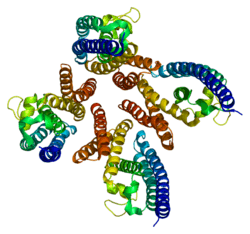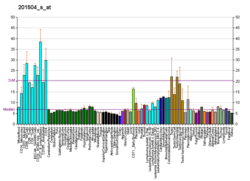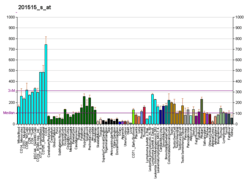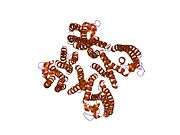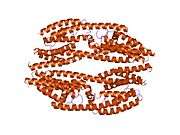Translin
Translin is a DNA-binding protein that in humans is encoded by the TSN gene.[4][5][6] Together with translin-associated factor X, translin forms the component 3 of promoter of RISC (C3PO) complex which facilitates endonucleolytic cleavage of the passenger strand during microRNA loading into the RNA-induced silencing complex (RISC).[7][8][9]
Function
This gene encodes a DNA-binding protein which specifically recognizes conserved target sequences at the breakpoint junction of chromosomal translocations. Translin polypeptides form a multimeric structure that is responsible for its DNA-binding activity. Recombination-associated motifs and translin-binding sites are present at recombination hotspots and may serve as indicators of breakpoints in genes which are fused by translocations. These binding activities may play a crucial role in chromosomal translocation in lymphoid neoplasms.[6]
References
- GRCh38: Ensembl release 89: ENSG00000211460 - Ensembl, May 2017
- "Human PubMed Reference:". National Center for Biotechnology Information, U.S. National Library of Medicine.
- "Mouse PubMed Reference:". National Center for Biotechnology Information, U.S. National Library of Medicine.
- Kasai M, Aoki K, Matsuo Y, Minowada J, Maziarz RT, Strominger JL (July 1994). "Recombination hotspot associated factors specifically recognize novel target sequences at the site of interchromosomal rearrangements in T-ALL patients with t(8;14)(q24;q11) and t(1;14)(p32;q11)". International Immunology. 6 (7): 1017–25. doi:10.1093/intimm/6.7.1017. PMID 7947454.
- Aoki K, Inazawa J, Takahashi T, Nakahara K, Kasai M (July 1997). "Genomic structure and chromosomal localization of the gene encoding translin, a recombination hotspot binding protein". Genomics. 43 (2): 237–41. doi:10.1006/geno.1997.4796. PMID 9244443.
- "Entrez Gene: TSN translin".
- Liu Y, Ye X, Jiang F, Liang C, Chen D, Peng J, Kinch LN, Grishin NV, Liu Q (August 2009). "C3PO, an endoribonuclease that promotes RNAi by facilitating RISC activation". Science. 325 (5941): 750–3. doi:10.1126/science.1176325. PMC 2855623. PMID 19661431.
- Ye X, Huang N, Liu Y, Paroo Z, Huerta C, Li P, Chen S, Liu Q, Zhang H (June 2011). "Structure of C3PO and mechanism of human RISC activation". Nature Structural & Molecular Biology. 18 (6): 650–7. doi:10.1038/nsmb.2032. PMC 3109212. PMID 21552258.
- Ha M, Kim VN (August 2014). "Regulation of microRNA biogenesis". Nature Reviews Molecular Cell Biology. 15 (8): 509–24. doi:10.1038/nrm3838. PMID 25027649.
- Hasegawa T, Isobe K (August 1999). "Evidence for the interaction between Translin and GADD34 in mammalian cells". Biochimica et Biophysica Acta (BBA) - General Subjects. 1428 (2–3): 161–8. doi:10.1016/s0304-4165(99)00060-4. PMID 10434033.
Further reading
- Aoki K, Suzuki K, Sugano T, Tasaka T, Nakahara K, Kuge O, Omori A, Kasai M (June 1995). "A novel gene, Translin, encodes a recombination hotspot binding protein associated with chromosomal translocations". Nature Genetics. 10 (2): 167–74. doi:10.1038/ng0695-167. PMID 7663511.
- Maruyama K, Sugano S (January 1994). "Oligo-capping: a simple method to replace the cap structure of eukaryotic mRNAs with oligoribonucleotides". Gene. 138 (1–2): 171–4. doi:10.1016/0378-1119(94)90802-8. PMID 8125298.
- Aoki K, Nakahara K, Ikegawa C, Seto M, Takahashi T, Minowada J, Strominger JL, Maziarz RT, Kasai M (April 1994). "Nuclear proteins binding to a novel target sequence within the recombination hotspot regions of Bcl-2 and the immunoglobulin DH gene family". Oncogene. 9 (4): 1109–15. PMID 8134113.
- Aoki K, Ishida R, Kasai M (January 1997). "Isolation and characterization of a cDNA encoding a Translin-like protein, TRAX". FEBS Letters. 401 (2–3): 109–12. doi:10.1016/S0014-5793(96)01444-5. PMID 9013868.
- Kasai M, Matsuzaki T, Katayanagi K, Omori A, Maziarz RT, Strominger JL, Aoki K, Suzuki K (April 1997). "The translin ring specifically recognizes DNA ends at recombination hot spots in the human genome". The Journal of Biological Chemistry. 272 (17): 11402–7. doi:10.1074/jbc.272.17.11402. PMID 9111049.
- Suzuki Y, Yoshitomo-Nakagawa K, Maruyama K, Suyama A, Sugano S (October 1997). "Construction and characterization of a full length-enriched and a 5'-end-enriched cDNA library". Gene. 200 (1–2): 149–56. doi:10.1016/S0378-1119(97)00411-3. PMID 9373149.
- Hasegawa T, Isobe K (August 1999). "Evidence for the interaction between Translin and GADD34 in mammalian cells". Biochimica et Biophysica Acta (BBA) - General Subjects. 1428 (2–3): 161–8. doi:10.1016/s0304-4165(99)00060-4. PMID 10434033.
- Badge RM, Yardley J, Jeffreys AJ, Armour JA (May 2000). "Crossover breakpoint mapping identifies a subtelomeric hotspot for male meiotic recombination". Human Molecular Genetics. 9 (8): 1239–44. doi:10.1093/hmg/9.8.1239. PMID 10767349.
- Hosaka T, Kanoe H, Nakayama T, Murakami H, Yamamoto H, Nakamata T, Tsuboyama T, Oka M, Kasai M, Sasaki MS, Nakamura T, Toguchida J (November 2000). "Translin binds to the sequences adjacent to the breakpoints of the TLS and CHOP genes in liposarcomas with translocation t(12;6)". Oncogene. 19 (50): 5821–5. doi:10.1038/sj.onc.1203943. PMID 11126370.
- Chennathukuzhi VM, Kurihara Y, Bray JD, Hecht NB (April 2001). "Trax (translin-associated factor X), a primarily cytoplasmic protein, inhibits the binding of TB-RBP (translin) to RNA". The Journal of Biological Chemistry. 276 (16): 13256–63. doi:10.1074/jbc.M009707200. PMID 11278549.
- Lee SP, Fuior E, Lewis MS, Han MK (November 2001). "Analytical ultracentrifugation studies of translin: analysis of protein-DNA interactions using a single-stranded fluorogenic oligonucleotide". Biochemistry. 40 (46): 14081–8. doi:10.1021/bi010302t. PMID 11705401.
- Erdemir T, Bilican B, Oncel D, Goding CR, Yavuzer U (January 2002). "DNA damage-dependent interaction of the nuclear matrix protein C1D with Translin-associated factor X (TRAX)". Journal of Cell Science. 115 (Pt 1): 207–16. PMID 11801738.
- Han MK, Lin P, Paek D, Harvey JJ, Fuior E, Knutson JR (March 2002). "Fluorescence studies of pyrene maleimide-labeled translin: excimer fluorescence indicates subunits associate in a tail-to-tail configuration to form octamer". Biochemistry. 41 (10): 3468–76. doi:10.1021/bi015901e. PMID 11876655.
- Sengupta K, Rao BJ (December 2002). "Translin binding to DNA: recruitment through DNA ends and consequent conformational transitions". Biochemistry. 41 (51): 15315–26. doi:10.1021/bi026378m. PMID 12484770.
- Li K, Wang L, Cheng J, Lu YY, Zhang LX, Mu JS, Hong Y, Liu Y, Duan HJ, Wang G, Li L, Chen JM (February 2003). "Interaction between hepatitis C virus core protein and translin protein--a possible molecular mechanism for hepatocellular carcinoma and lymphoma caused by hepatitis C virus". World Journal of Gastroenterology. 9 (2): 300–3. doi:10.3748/wjg.v9.i2.300. PMC 4611333. PMID 12532453.
- Yang S, Cho YS, Chennathukuzhi VM, Underkoffler LA, Loomes K, Hecht NB (March 2004). "Translin-associated factor X is post-transcriptionally regulated by its partner protein TB-RBP, and both are essential for normal cell proliferation". The Journal of Biological Chemistry. 279 (13): 12605–14. doi:10.1074/jbc.M313133200. PMID 14711818.
External links
- Overview of all the structural information available in the PDB for UniProt: Q15631 (Human Translin) at the PDBe-KB.
- Overview of all the structural information available in the PDB for UniProt: Q62348 (Mouse Translin) at the PDBe-KB.
